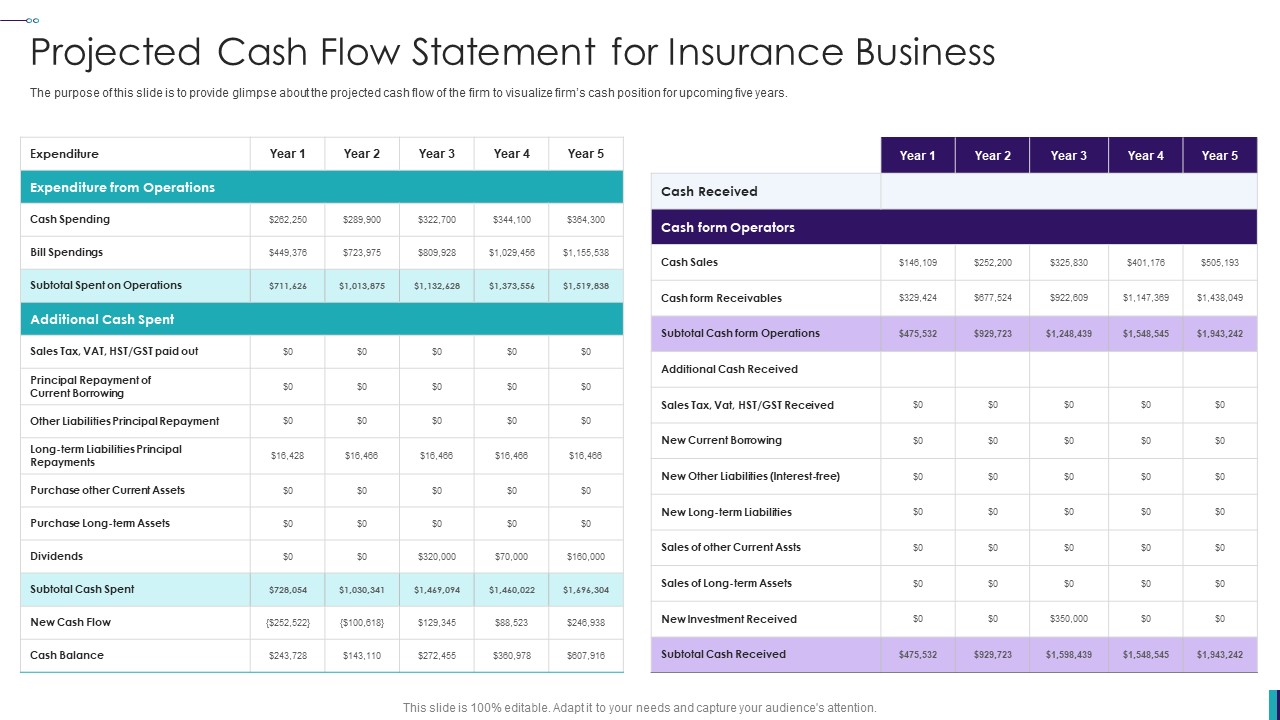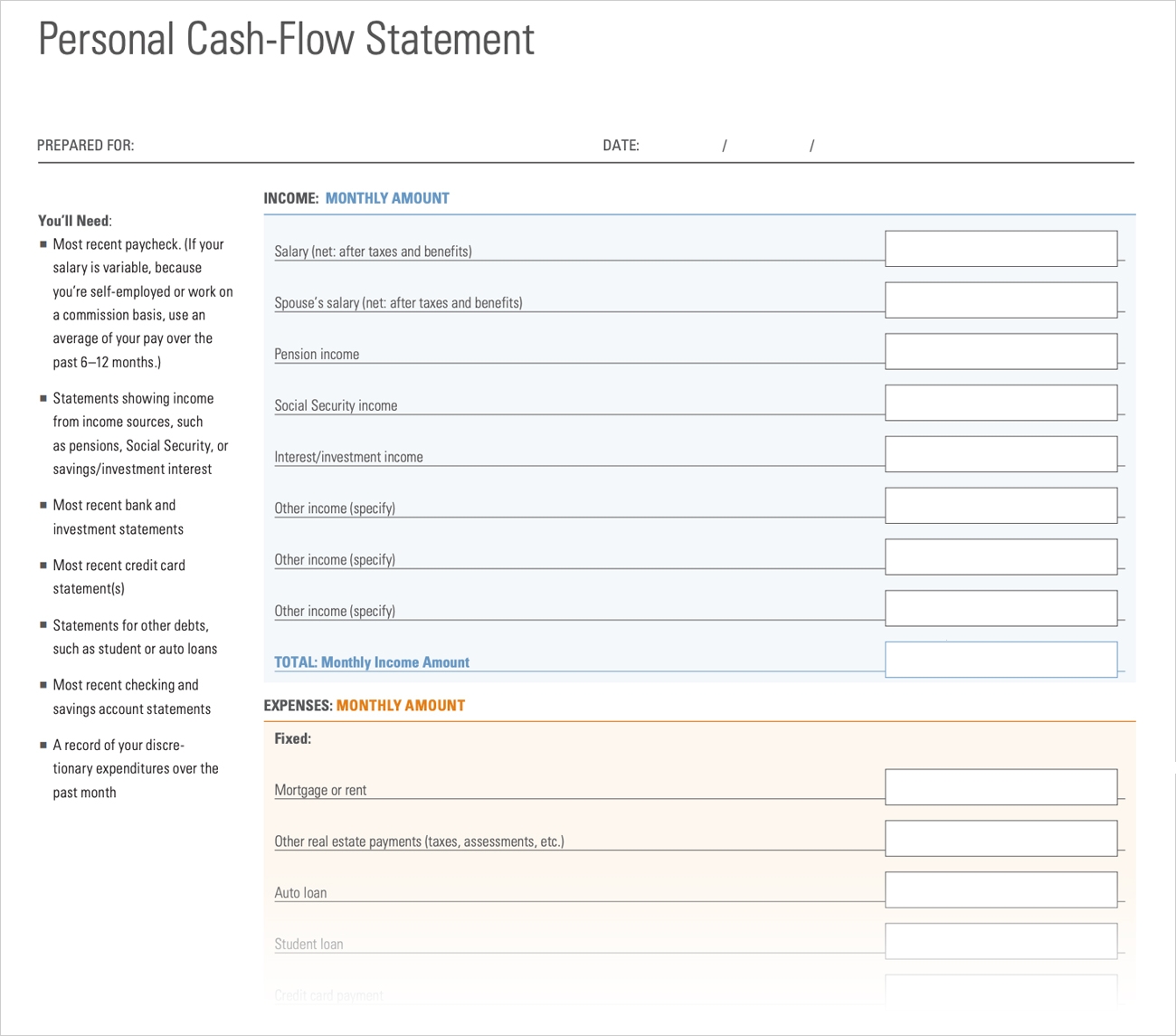

Finance
What Is Cash Flow In A Business
Published: December 20, 2023
Learn the importance of cash flow in a business and how it impacts finance. Discover key strategies to manage and optimize your business's cash flow, ensuring financial stability and growth.
(Many of the links in this article redirect to a specific reviewed product. Your purchase of these products through affiliate links helps to generate commission for LiveWell, at no extra cost. Learn more)
Table of Contents
Introduction
Running a successful business involves more than just generating revenue and making sales. It also requires careful management of your financial resources to ensure the smooth day-to-day operations and long-term growth of your company. One critical aspect of financial management is cash flow.
Cash flow refers to the movement of money into and out of a business. It shows how much cash is available to the business at any given time and is a key indicator of its financial health. Understanding and effectively managing cash flow is essential for sustaining a profitable business.
In this article, we will delve into the concept of cash flow in a business, its importance, and how to manage it effectively. We will explore the components of cash flow, the difference between positive and negative cash flow, and the significance of cash flow statements and analysis. By the end, you will have a thorough understanding of cash flow and why it is crucial for your business’s success.
Definition of Cash Flow
Cash flow is a financial metric that measures the amount of cash or cash equivalents flowing in and out of a business within a specific period. It provides a clear picture of a company’s ability to generate and manage its cash resources.
There are three main components that make up cash flow:
- Operating Cash Flow: This refers to the cash generated from a company’s core business activities, such as sales of products or services and payment of expenses. It represents the cash flow from the company’s day-to-day operations.
- Investing Cash Flow: This includes cash flows related to investments in assets or financial instruments, such as purchasing new equipment, acquiring other businesses, or making investments in stocks or bonds. It reflects the cash flow from the company’s investment activities.
- Financing Cash Flow: This represents cash flows related to raising capital or repaying debt. It includes activities such as issuing or repurchasing shares, obtaining loans, or making repayments on outstanding debt. It indicates the cash flow from the company’s financing activities.
Cash flow can be either positive or negative. A positive cash flow means that the company is generating more cash than it’s spending, resulting in a surplus of cash. This is generally considered a healthy sign for a business, as it signifies its ability to cover expenses, invest in growth opportunities, and repay debts.
On the other hand, a negative cash flow indicates that the company is spending more cash than it’s generating, resulting in a shortfall of cash. This can be a worrisome sign, as it may lead to problems with meeting financial obligations and hinder the company’s growth prospects.
Understanding the components and implications of cash flow is essential for effective financial management. By monitoring and analyzing cash flow, businesses can make informed decisions, identify areas for improvement, and proactively manage their financial resources, leading to long-term sustainability and profitability.
Importance of Cash Flow in Business
Cash flow is often referred to as the “lifeblood” of a business, and for good reason. It plays a vital role in the day-to-day operations and long-term success of any company. Here are some key reasons why cash flow is crucial in business:
- Meeting Financial Obligations: A healthy cash flow ensures that a business can pay its bills, cover expenses, and meet its financial obligations on time. This includes payment of salaries, suppliers, rent, utilities, and loan repayments. Without sufficient cash flow, a business may face cash shortages, resulting in late payments, missed opportunities, and damaged relationships with stakeholders.
- Investing in Growth: Positive cash flow enables a business to invest in growth opportunities. Whether it’s expanding operations, launching new products or services, or entering new markets, having cash on hand provides the financial resources required to fund these initiatives. Investing in growth is essential for staying competitive, attracting customers, and increasing profitability.
- Managing Seasonal Fluctuations: Many businesses experience seasonal fluctuations in sales and revenue. During off-peak seasons, when sales are lower, cash flow becomes crucial for covering expenses and keeping the business running smoothly. Adequate cash reserves allow the business to weather these slower periods without resorting to excessive borrowing or other financial hardships.
- Addressing Unexpected Expenses: Inevitably, unexpected expenses or emergencies can arise in business. Whether it’s equipment breakdown, legal issues, or unforeseen market conditions, having sufficient cash flow provides the flexibility to address these challenges. It allows businesses to handle unexpected expenses without disrupting operations or jeopardizing their financial stability.
- Evaluating Financial Health: Cash flow analysis is a valuable tool for assessing the financial health and performance of a business. By comparing inflows and outflows of cash, analyzing trends, and identifying patterns, businesses can gain valuable insights into their financial position. This information enables proactive decision-making, highlighting areas for improvement, and guiding strategic planning.
Overall, maintaining a positive and consistent cash flow is essential for the stability, growth, and long-term success of a business. It ensures the ability to meet financial obligations, invest in growth, manage fluctuations, handle unexpected expenses, and make informed financial decisions. By prioritizing cash flow management, businesses can build a solid foundation for sustainable profitability and achieve their strategic objectives.
Components of Cash Flow
Cash flow is composed of three main components that reflect different aspects of a business’s financial activities. Understanding these components is essential for effectively managing and analyzing cash flow. Let’s explore each component in detail:
- Operating Cash Flow: This component represents the cash generated from a company’s core business operations. It includes cash inflows from sales revenue, customer payments, and other operating activities. On the other hand, it includes cash outflows related to expenses such as salaries, rent, utilities, inventory, and other operating costs. Operating cash flow indicates the cash generated or utilized by the day-to-day operations of the business. A positive operating cash flow is generally a positive sign, indicating that the company is generating enough cash from its core activities.
- Investing Cash Flow: Investing cash flow accounts for the cash flows related to investments in assets or financial instruments. It includes cash inflows from selling assets, receiving dividends or interest, and cash outflows from purchasing new equipment, property, or other long-term investments. Investing cash flow reflects the company’s capital expenditure and investment activities. Positive investing cash flow indicates that the company is making strategic investments to expand and improve its operations.
- Financing Cash Flow: Financing cash flow represents the cash flows associated with raising capital or repaying debt. It includes cash inflows from issuing stocks or bonds, borrowing money, or receiving capital contributions. On the other hand, it includes cash outflows related to repaying loans, paying dividends to shareholders, or buying back shares. Financing cash flow reflects the company’s financial structure and sources of capital. Positive financing cash flow suggests that the company is effectively raising capital or managing its debt obligations.
By analyzing these components, businesses can gain valuable insights into their cash flow patterns and financial activities. It allows them to assess the impact of their operating, investing, and financing decisions on cash flow. Understanding the components helps businesses identify areas where they can improve cash flow and make informed financial decisions.
It’s important to note that while these components provide a comprehensive understanding of cash flow, they are interrelated and can overlap. For example, a company may generate cash from selling an asset (investing cash flow) and simultaneously use that cash to pay off a loan (financing cash flow). Therefore, it’s crucial to consider all components collectively to have a holistic view of a business’s cash flow position.
Positive and Negative Cash Flow
Cash flow can be categorized as either positive or negative, depending on the net result of cash inflows and outflows during a specific period. Let’s explore the concepts of positive and negative cash flow in more detail:
Positive Cash Flow:
A positive cash flow occurs when a business generates more cash inflows than outflows within a given period. This means that the company has a surplus of cash at the end of the period. Positive cash flow is generally seen as a favorable sign for a business, indicating its ability to cover expenses, invest in growth opportunities, and meet financial obligations.
Positive cash flow provides several benefits for a business, including:
- The ability to easily pay bills, suppliers, and employees on time
- Opportunities to invest in expanding operations, launching new products, or entering new markets
- A stronger financial position, allowing for better negotiation power with lenders or investors
- Improved cash reserves to handle unexpected expenses or economic downturns
Negative Cash Flow:
A negative cash flow occurs when a business’s cash outflows exceed its inflows during a specific period. This means that the company is spending more cash than it is generating. Negative cash flow can be a cause for concern, as it may indicate financial instability and potential difficulties in meeting financial obligations.
Negative cash flow can result from various factors, including:
- Decreased sales or revenue
- High operating expenses or overhead costs
- Investments in new ventures or expansion that haven’t yet yielded returns
- Large loan repayments or debt obligations
While negative cash flow is generally seen as unfavorable, it doesn’t necessarily mean that the business is failing. In some cases, businesses intentionally incur negative cash flow to invest in long-term growth. However, it is important for businesses to closely monitor and manage negative cash flow to avoid cash shortages and financial distress.
Regular cash flow analysis and forecasting can help businesses identify the root causes of negative cash flow and take appropriate measures to improve it. This may involve reducing expenses, increasing sales efforts, renegotiating payment terms with suppliers or lenders, or seeking additional sources of funding.
In summary, positive cash flow is generally desired for the financial health and sustainability of a business, while negative cash flow requires careful management and strategic decision-making. By understanding and actively managing cash flow, businesses can ensure they have sufficient resources to thrive and navigate through various financial challenges.
Managing Cash Flow
Effectively managing cash flow is crucial for the financial stability and success of a business. It involves actively monitoring, analyzing, and controlling the movement of cash into and out of the company. Here are some key strategies and tips for managing cash flow:
- Create a Cash Flow Forecast: Develop a cash flow forecast by estimating your expected cash inflows and outflows for a specific period. This allows you to anticipate potential cash gaps or surpluses and plan accordingly. Review and update your cash flow forecast regularly to reflect changes in your business environment and adjust your cash management strategies accordingly.
- Optimize Invoicing and Collections: Send out accurate and timely invoices to your customers and have a clear payment policy in place. Offer incentives for early payments and follow up on overdue payments promptly. Consider implementing electronic payment options to speed up the collections process and ensure a steady stream of cash inflows.
- Manage Expenses: Analyze your expenses and identify areas where you can reduce costs without compromising the quality of your products or services. Negotiate favorable terms with suppliers, explore bulk purchasing options, and regularly review your expenses to eliminate unnecessary or excessive spending.
- Monitor Inventory: Optimize your inventory management to prevent overstocking or understocking. Excess inventory ties up cash that could be used elsewhere, while insufficient inventory leads to lost sales opportunities. Implement inventory control systems, monitor sales trends, and establish strong relationships with suppliers to ensure a smooth supply chain.
- Implement Cash Flow Controls: Establish financial controls and procedures to manage cash flow effectively. This may include setting spending limits, implementing approval processes for expenses, and monitoring cash flow patterns to spot anomalies or potential cash flow issues early on. Use cash flow management software or tools to streamline and automate cash flow processes.
- Budget Wisely: Develop a comprehensive budget that aligns with your cash flow forecast. Track actual expenditures against the budget and make adjustments as needed to stay on track. A well-planned budget helps you allocate your resources effectively and keeps your spending in check.
- Build Cash Reserves: Aim to build a cash reserve to serve as a buffer during lean periods or unexpected expenses. Set aside a portion of your profits regularly to build up these reserves. Having cash reserves provides you with financial flexibility and peace of mind.
- Consider Financing Options: Explore financing options such as small business loans, lines of credit, or invoice financing to support your cash flow needs. However, use caution and ensure that the cost of financing does not outweigh the benefits. Evaluate the terms and interest rates of the financing options and choose the one that aligns with your cash flow requirements and long-term financial goals.
By implementing these strategies and staying vigilant about managing your cash flow, you can ensure that your business maintains a healthy and sustainable financial position. Regularly review and revise your cash flow management practices to adapt to changing market conditions and seize growth opportunities.
Cash Flow Statement
The cash flow statement is a financial statement that provides an overview of the cash inflows and outflows of a business during a specific period. It captures the movement of cash from operating, investing, and financing activities, offering valuable insights into a company’s liquidity and cash management.
The cash flow statement consists of three main sections:
- Cash Flow from Operating Activities: This section reports the cash generated or utilized by a company’s core business operations. It includes cash inflows from sales revenue, customer payments, and other operating income. It also incorporates cash outflows related to expenses, such as salaries, rent, utilities, and other operating costs. Operating activities provide a measure of a business’s cash-generating ability.
- Cash Flow from Investing Activities: This section details the cash flows related to a company’s investments in assets or financial instruments. It includes cash inflows from the sale of fixed assets, investments, or securities. It also reflects cash outflows from the purchase of new equipment, properties, or other long-term investments. Investing activities provide insights into a company’s capital expenditure and investment decisions.
- Cash Flow from Financing Activities: This section showcases the cash flows related to a company’s financing operations. It includes cash inflows from issuing stocks or bonds, borrowing money, or receiving capital contributions. It also records cash outflows related to loan repayments, dividend payments, share buybacks, or other financing obligations. Financing activities provide a snapshot of a company’s financial structure and its ability to raise capital.
The cash flow statement is essential for assessing a company’s liquidity position and its ability to meet short-term obligations. It provides valuable information for investors, creditors, and other stakeholders to evaluate the cash flow generation, cash management practices, and financial health of a business.
By analyzing the cash flow statement, businesses can identify trends, patterns, and potential areas for improvement. They can assess their cash flow sustainability, identify cash flow gaps or surpluses, and adjust their financial strategies accordingly. The cash flow statement aids in making informed decisions related to budgeting, investment planning, and financing activities.
It’s important to note that the cash flow statement complements other financial statements like the income statement and balance sheet. Analyzing the cash flow statement in conjunction with these statements provides a comprehensive understanding of a company’s financial position.
Accurate and regularly updated cash flow statements are crucial for effective financial management. They allow businesses to monitor their cash flow performance, make informed financial decisions, allocate resources effectively, and plan for future growth and financial stability.
Cash Flow Analysis
Cash flow analysis is a process of examining the inflows and outflows of cash within a business to gain insights into its cash management practices and financial health. It involves the evaluation of a company’s cash flow statement and other financial data to assess its liquidity, profitability, and sustainability.
Here are some key aspects of cash flow analysis:
- Trend Analysis: By comparing cash flow statements over multiple periods, businesses can identify trends and patterns in their cash flow. This helps in understanding the consistency of cash inflows and outflows, and whether the business is improving or experiencing challenges. Trend analysis can identify seasonal variations, identify areas of concern, and inform future financial planning.
- Cash Conversion Cycle: The cash conversion cycle measures the time it takes for a business to convert its investments in inventory and other resources into cash inflows from sales. Analyzing this cycle can help identify bottlenecks in the production and sales processes, optimize operations, and improve cash flow efficiency.
- Operating Cash Flow Margin: The operating cash flow margin indicates the percentage of revenue that is converted into operating cash flow. It determines how effectively a business is generating cash from its core operations. A higher margin suggests healthy profitability and cash generation, while a lower margin may indicate inefficiencies or challenges in generating sufficient cash from operations.
- Free Cash Flow: Free cash flow represents the cash that remains after deducting capital expenditures from the operating cash flow. It provides insight into a business’s ability to generate cash while maintaining and expanding its asset base. Positive free cash flow indicates that a company has excess cash available for dividends, investments, debt repayment, or other uses.
- Cash Flow Ratios: Various ratios are used to evaluate a company’s cash flow performance. These include the cash flow coverage ratio, which measures a company’s ability to cover its fixed expenses with operating cash flow, and the cash flow return on investment (CFROI), which evaluates the return generated from invested capital. These ratios help assess the financial viability and efficiency of cash flow management.
- Industry Comparison: Analyzing a company’s cash flow in relation to industry benchmarks or competitors can provide valuable insights into its standing within the market. Comparisons help identify areas where a company may be lagging or excelling in terms of cash flow management, profitability, and financial stability.
By conducting a comprehensive cash flow analysis, businesses can identify areas for improvement, make informed financial decisions, and implement strategies to enhance their cash flow. It helps in ensuring sufficient liquidity, managing working capital effectively, and sustaining long-term profitability. Cash flow analysis is essential for financial planning, budgeting, securing financing, and overall business growth.
Cash Flow Projections
Cash flow projections, also known as cash flow forecasting, involve the estimation of a company’s future cash inflows and outflows based on anticipated sales, expenses, and other factors. Cash flow projections provide businesses with valuable insights into their expected cash position, allowing for effective financial planning and decision-making.
Here are some key considerations when creating cash flow projections:
- Sales Forecast: Begin by estimating your future sales based on historical data, market trends, and anticipated changes in customer demand. Consider factors such as seasonality, industry trends, and the impact of economic conditions on sales. Accurate sales forecasting is crucial for projecting cash inflows.
- Accounts Receivable: Estimate the timing of customer payments and the average collection period. Analyze your historical collection data and payment terms to determine the expected timing of cash inflows from outstanding invoices. Projecting accounts receivable accurately is essential for projecting cash inflows.
- Expenses and Accounts Payable: Anticipate your future expenses, including payroll, rent, utilities, inventory purchases, and other operating costs. Consider factors such as inflation, cost fluctuations, and business expansion plans. Estimate the timing of accounts payable, taking into account payment terms and supplier agreements.
- Capital Expenditures: Consider any anticipated capital expenditures, such as equipment purchases or facility expansion projects. Determine when these expenditures will occur and their impact on cash outflows. Projecting capital expenditures accurately is crucial for understanding cash flow financing needs.
- Profit Margins: Analyze your historical profit margins and consider any expected changes. Changes in pricing, costs, or market conditions can impact profit margins and consequently, cash flow. Adjust your projections accordingly to reflect anticipated changes in profitability.
- External Factors: Take into account any external factors that may impact cash flow, such as changes in regulations, interest rates, or economic conditions. These factors can influence customer purchasing behavior, supplier pricing, and overall business performance.
- Scenario Analysis: Consider conducting scenario analysis by creating multiple projections based on different assumptions. This allows you to assess the potential impact of different scenarios on cash flow, such as best-case, worst-case, and most likely scenarios. Scenario analysis helps in understanding potential risks and developing contingency plans.
Regularly monitor and update your cash flow projections as new information becomes available or circumstances change. Compare your actual cash flow to your projections and identify any variances to refine your forecasting accuracy over time.
By creating cash flow projections, businesses can anticipate cash shortages or surpluses, plan for financing needs, optimize cash management strategies, and make informed decisions about investments, expenses, and business growth. Cash flow projections provide a valuable tool for managing cash flow effectively and ensuring the financial stability and success of a business.
Conclusion
Cash flow is a vital aspect of financial management in any business. It is the lifeblood that fuels day-to-day operations, allows for growth and investment, and ensures financial stability. Understanding and effectively managing cash flow is essential for the long-term success and sustainability of a business.
In this article, we explored the definition of cash flow and its significance in a business context. We discussed the components of cash flow – operating, investing, and financing – and how they contribute to the overall cash position of a company. We also explored the concepts of positive and negative cash flow and the importance of managing cash flow to ensure a healthy financial position.
We delved into the cash flow statement and its role in providing insights into cash inflows and outflows, as well as its relevance for financial analysis and decision-making. Additionally, we discussed the importance of cash flow analysis in understanding a company’s liquidity, profitability, and overall financial health.
Managing cash flow requires careful planning, monitoring, and control. By implementing strategies such as cash flow forecasting, optimizing invoicing and collections, managing expenses, and building cash reserves, businesses can effectively manage their cash flow and ensure financial stability.
Finally, we discussed the importance of cash flow projections in anticipating future cash flows and planning for potential challenges or opportunities. By creating accurate cash flow projections based on sales forecasts, expense estimates, and other factors, businesses can make informed decisions, identify areas for improvement, and optimize their cash flow management strategies.
In conclusion, cash flow is a critical aspect of financial management that every business should prioritize. By understanding, analyzing, and managing cash flow effectively, businesses can improve their financial performance, make informed decisions, and position themselves for long-term success and growth.














